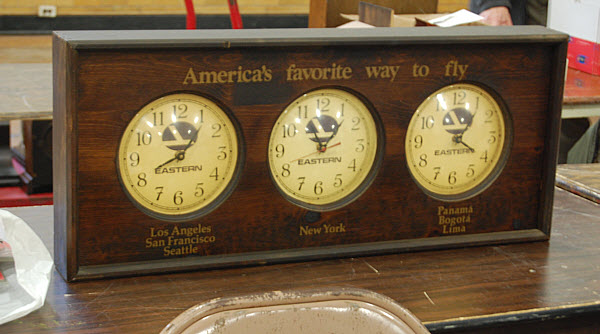Meetings PastNovember 16, 2013 Meeting Highlights Chapter 148 met on the morning of Saturday November 11. It was very nice to greet old friends--and to meet new ones, as our chapter continues to grow. This, our final meeting of 2013, featured mart, silent auction, and raffle. Items spotted at the mart included a John William Norie & Co. brass and ebony navigator's sextant ca. 1830; a Seth Thomas Clock Co., Thomaston, CT chime clock No. 71, with a Model 113A movement and Westminster chimes, ca. 1922 (see photo below); and an early Telechron synchronous motor slave clock movement. Many excellent deals were to be found, including an assortment of free Bulletins and old auction catalogs. A long time collector exhibited an early Ingersoll non-jewelled "Yankee Back Wind" pocket watch, in mint condition, with the original guarantee paper dated January 24, [19]02, inside the case. It was quite a thrill to see, and to have the chance to talk about, this historically interesting item with folks who share an appreciation for such uniquely American artifacts. We learned that the Town of Thomaston, CT has published a brochure entitled "Thomaston [CT] Clock Walks". While not exclusively devoted to clock making sites, the brochure contains much information on Seth Thomas clock making sites and associated residences. Interested persons may obtain a free copy by contacting the Thomaston [CT] Public Library via its web site. http://www.thomastonlibrary.org/ The chapter extends its heartiest best wishes for a speedy recovery to longtime member George Bruno, who was scheduled to be our guest speaker on the subject of his recent completion of a working model of Eli Terry's Porter Contract gear cutting engine. However, just as the meeting announcements went out, George suffered a hip fracture from a fall, and was unable to attend. Despite the distressing news, we are pleased to report George is on the mend, and look forward to the pleasure of hearing his presentation (not to mention his spirited company!) shortly. Many thanks is due to our talented volunteers, especially Don and Carol Montenay; Jon Jacobi; and David Ewbank; and to our incredibly gracious chapter officers, Al and Cheryl Comen, whose hard work over the past year consistently produced rewarding, educational, and successful chapter meetings! Happy holidays to all! -- Mary Jane Dapkus * * * September 21, 2013 Meeting Highlights Chapter 148 met on the morning of Saturday, September 21st 2013. The meeting was very well attended. Members chatted pleasantly while browsing mart offerings, which included a good selection of brass, and some wooden movement shelf clocks; early pocket watches; wrist watches; books; and ephemera. Lu Sadowski presented information on upcoming NAWCC events. Chapter members swapped information about clockmaking sites in Connecticut they have visited or would like to visit in the future. We learned that the American Clock & Watch Museum has recently published Volume 7, No. 2 of the Timepiece Journal, containing several items of interest on clock makers Joseph Ives and Chauncey Goodrich.
Next Mel explained and showed various cutting tools, along with some accessories he made himself, with applications to clock work that could be used with the machine, speaking briefly about the strengths and weaknesses of each. He showed us how to use a vice to hold small work, and how to strap the work over a spacer so as to avoid damaging the work as it progressed. Working in brass (to avoid the use of oil in the program room as would be required with steel work), Mel proceeded to show us the steps in setting up the machine to cut a key way in a shaft, and then proceeded to cut the key way. From there he moved on to the more complex job of setting up the machine to blank and spoke a clock wheel, and proceeded to cut part of a wheel. Mel touched briefly on the subject of cutting wheel teeth, showing us an example of a tooth cutter for the machine, and passing around photographs to show how it is used. Likewise he showed us photos of the machine being used to cut tower clock pinions. Mel spent most of his professional life in the construction industry. He began teaching himself how to use a jig saw, drill press, and other machine tools at about the age of 12. As things turned out, today he is one of our chapter's top experts in watch and tower clock repair. One of his favorite sources of information is a book entitled: A Treatise on Milling & Milling Machines, published by the Brown & Sharpe Manufacturing Co. in 1943. Mel performs all calculations and writes a brief work plan before beginning to work on a particular piece, becoming thoroughly acquainted with all the aspects of a project. In contrast, today's machinists program their work, and the milling machines automatically perform all the calculations. But today's programmable machines are very costly--far out of reach for most hobbyists and repairers--which is one reason Mel's skills so rare and desirable from our perspective. Thanks is due to Mel and to all the others whose hard work made this meeting an enjoyable learning experience! * * * July 20, 2013 Meeting Highlights On the steamy Saturday morning of July 20, Chapter 148 members found respite in the Edmond Town Hall's cool gymnasium. It was good to visit with old friends and new, and especially to welcome member and long-time friend John Bolton back from his travels. Amidst a glorious summer mart in full swing, the meeting featured a number of informal educational presentations, one being a mini-exhibit curated by member David Follett. Drawing from his own collection, David demonstrated a crank-operated brass watch or clock maker's rounding up tool, patented ca. 1889, not only in a superb state of preservation, but also in working condition, complete with collets and disc accessories--an especially lovely example of an historic tool.
David cheerfully entertained questions from the crowd that quickly gathered around his table. Briefly, a rounding up tool provided a means of smoothing both sides of the "valleys" between gear teeth cut on a wheel cutting engine, so as to reduce friction when the new gears engage the adjacent pinions. The tool bore the marks of its maker, L[ouis] Carpano, of Cluses, France. Gears placed in the tool were automatically centered, with the accessory discs functioning (in part) to prevent removal of too much material from the work. At the adjoining table, Lydia Rufleth and George Bruno teamed to demonstrate George's method of casting replacement pewter tall clock hands. Briefly, George makes a mold from special ceramic material, which receives the impressions of a pair of original hands, one on each side. After the mold is allowed to cure, rubber protectors are placed over the top and bottom surfaces, then wooden plates are clamped over the mold. Molten pewter is poured into an opening left at one end. The cooled hands can be easily removed. Chris Brooks brought a Model 1, 18s, 3/4-plate, 11j, "slow train" Seth Thomas pocket watch, in mint condition, in its original nickel case. The watch's movement bears only one patent date, that of January 15, 1885. Its serial # is 636, so the watch likely predates the Model 1's more often seen that have two patent dates. Chris purchased this important example in an antique shop ca. 1972--an incredible good luck story! Meanwhile, Mel Smith presented a superb collection of American military issue pocket and wrist watches dating from World War I to the present. Mel graciously offered watches for examination while he patiently answered rapid fire questions from the crowd. Many of the watches in Mel's collection were of American make, but some were actually European. All were marked by the U.S. military. Several of the early wrist models had an eerie feature called a "schrapnel guard" to protect their glass crystals. A World War I era wrist watch with a period band predated coordinate navigation. Several of the watches were marked "Army Air Corps", dating them to World War II. Several (later) Air Force pocket watches had black dials, sweep seconds hands, and hack features. A Hamilton 4992B navigation pocket watch with a 24-hr. dial was set to Greenwich Civil Time. Korean War era watches were leftovers from World War II! Thanks to Mel we learned that Vietnam-era wrist watches were among the earliest to have plastic cases: a response to the deleterious effects of the jungle climate on metal movements. Despite coming on the heels of a week of sustained heat and humidity, the meeting was well attended, thanks in large measure to the efforts of our officers, Al and Cherly Comen, who thought of every detail to ensure our comfort--even down to bringing ice for our coffee. (THANK YOU!!) We would also like to thank all of our table holders, especially those who brought and organized exhibits for presentation, for their efforts. The result was an incredibly interesting meeting! * * * May 18, 2013 Meeting Highlights Chapter 148's May meeting took place on a glorious spring Saturday morning. Members chatted pleasantly while perusing mart offerings. Unusual items spotted included an early Waltham salesman's sample watch movement, and an early 20th c set of English chess timing clocks.
Jonathan Clark Brown (1807-1872) of Coventry, Ct. apprenticed as a cabinetmaker prior to his arrival in Bristol ca. 1832, as the shelf clock boom was well underway. Between 1832 and 1856, he was involved in no fewer than 14 different firms, most or all involving clocks. All of the firms with which Brown became identified earned solid reputations based on both the quality and attractiveness of their products. Howard graciously conducted us on a tour of Brown's uncataloged clock making past, comprehensively illustrating J.C. Brown 8-day, 2-day, and 1-day movements, and associating the movements with Brown's attractive cases, by means of an extensive set of beautiful slides. Howard explained the characteristics of Brown's 8-day 1/2-rectangular time-only fusee movements in "wall acorns", monumental mahogany veneered Empire triple deckers with elaborately etched and frosted glasses, various rippled case styles, ripple beehives with rare fusee movements and fusee alarms, marine octagon clocks with amusing patented latches, scarce Forestville Hardware & Clock Co. card-labeled clocks, porcelains, and other odd examples with as much relish as he did Brown's interesting, albeit more common, ogees. In listening to Howard describe his experiences in over 30 years of pursuing his passion for J.C. Brown clocks, members gained not only an appreciation for Brown's clocks, but also an insight into the ways in which collecting affords opportunities for personal growth. For example, despite all his experience as a collector, and his remarkable expertise in J.C. Brown clocks, Howard nonetheless retains a humble demeanor. Well aware that much is out there yet to be discovered, he concluded his talk by cautioning his audience never to speak in absolutes. Our sincerest thanks to Howard, and to all the others who shared with us their hard-earned wisdom at May's chapter meeting! * * * March 16, 2013 Meeting Highlights Chapter 148 met on March 16, a grey and chilly Saturday morning, filled nevertheless with the promise of spring. Browsing our mart, always an interesting and thought provoking experience, seemed especially so at the March meeting. Table holders offered a broad array of surprises ranging from fine antiques to exotic collectibles. Here is a very small sampling: a ca. late 19th century box clock with two dials and black glass door, labeled "Made by A.M. Johnson, New Haven, Conn." There was also a Gruen Persian Veri-Thin pocket watch; an "Aristo" Military Type A8 timer; a relatively old Bulova digital wristwatch in its original box; and an "Admiral Fitzroy" barometer. There was even an assortment of novelty erotic clocks (ca. late 19th - early 20th c?). Thanks is due to Joe Kaddis, Bob Mills, George Bruno, Cheryl Comen, and David Follett for bringing in examples of unusual antique clocks and movements for study, discussion, and photography. On a sad note, we learned that long time member and wood movement technical expert George Bruno had lost his wife of many years, Barbara, a few days ago, after a lengthy illness. Our memories of this woman, and of this couple together, in health, are very happy ones that cannot easily be erased. Sadly, we also recently learned that long time chapter member Don Weber passed away at his home in November 2012 at age 88. A native of Toledo, Ohio, Don attended the U.S. Navy V12 program from 1944 to 1946. Later he graduated from the University of Toledo. He was a skilled wood worker, sailor, clock repairer, and former Board member of the American Clock & Watch Museum of Bristol, CT. Don is survived by his wife Nancy. The pleasure of his company and warmth of his smile will be sorely missed. Planning and design phases for the American Clock & Watch Museum's new exhibit on Strickland vintage Art-Deco style watches are now well underway. The exhibit represents an exciting collaboration with a guest curator from far away (and sunny) Tampa, Florida, and will draw upon resources from both the Museum's collections and private ones.
Ch. 148's newest member, the cheerful and gregarious Ruby! Thanks to all who helped make our meeting an enjoyable and educational experience! * * * January 19, 2013 Meeting Highlights Chapter 148 met on the chilly Saturday morning of January 19. Members were greeted by the pleasant aroma of hot coffee, and the welcoming smiles of friendly faces. As they browsed the mart tables, they swapped items, work, holiday stories, and New Year news. As is chapter tradition, our January meeting did not include a speaker. Among the technical topics discussed was a mysterious unidentified, incomplete, iron mechanism about which member Lydia Rufleth is interested in obtaining further information. One observer noted that, since there are only two pivot holes (gears missing), the object was probably not a "slave" movement in a tower clock system. Furthermore, an alarm or bell was likely attached to the end of the worm gear, and the mechanism was apparently wound by the protruding shaft. Was it part of a fire alarm? (See photo in last Chapter highlights; thoughts welcome.) A lucky collector brought a lovely example of a first model Cheshire Watch Company pocket watch ca. 1885 to discuss with appreciative friends. Purchased nearly 40 years ago, this treasured item has gilt plates, a beveled crystal, excellent original dial, blued hands, and a four-digit serial number. The watch winds in only one direction, and is apparently installed in the factory's own nickel plated case, which the firm soon stopped making. The Cheshire Watch Co. is thought to have produced as few as 200 watches per day, which explains why they are seldom seen. In addition, we learned that the American Clock & Watch Museum has recently acquired a collection of documents related to the Cheshire Watch Co., the generous and thoughtful gift of a descendant of one of the firm's members. Items spotted at the mart included a nice example of an antique 19th c French mechanical singing bird in cage, in unrestored condition (not running). Also spotted was an interesting Eastern Airlines clock ca. mid-20th c, showing time in North and South America in three zones including New York City (see photo below).
A happy and healthy New Year to all! * * * Meetings In 2012 |
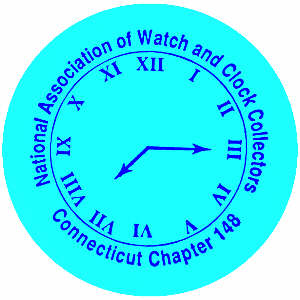
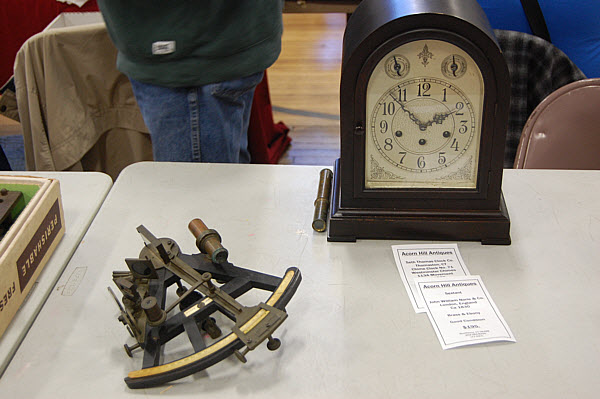
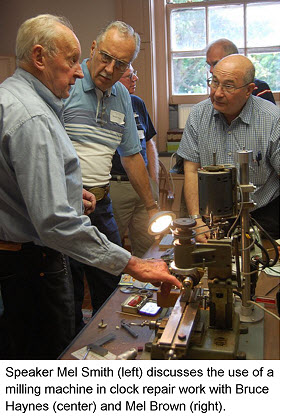 Our guest speaker was Mel Smith (NY), whose topic was a demonstration of the use of a milling machine in clock repair work. He began by showing us how to set up a Derbyshire milling machine.This high-quality, heavy duty instrument was produced in Waltham, MA, during the 1930s for use as a professional tool, in contrast to the less durable, lighter weight milling machines available for purchase by hobbyists today.
Our guest speaker was Mel Smith (NY), whose topic was a demonstration of the use of a milling machine in clock repair work. He began by showing us how to set up a Derbyshire milling machine.This high-quality, heavy duty instrument was produced in Waltham, MA, during the 1930s for use as a professional tool, in contrast to the less durable, lighter weight milling machines available for purchase by hobbyists today. 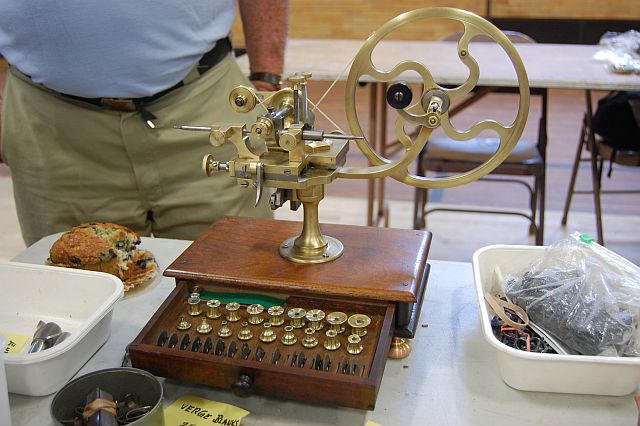
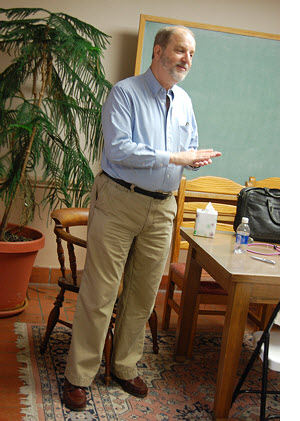 Our guest speaker was Dr. Howard Cohen, a friendly and energetic instructor of occupational health sciences at Yale University in "real life", perhaps better known to the NAWCC community as an avid collector of J.C. Brown clocks. Howard began by explaining that the best source of information on the subject of J.C. Brown, his career, and his clocks, remains the remarkable book by Kenneth D. Roberts and Snowden Taylor entitled: Jonathan Clark Brown and the Forestville Manufacturing Company (Fitzwilliam, NH: Ken Roberts Publishing Co.), 1988.
Our guest speaker was Dr. Howard Cohen, a friendly and energetic instructor of occupational health sciences at Yale University in "real life", perhaps better known to the NAWCC community as an avid collector of J.C. Brown clocks. Howard began by explaining that the best source of information on the subject of J.C. Brown, his career, and his clocks, remains the remarkable book by Kenneth D. Roberts and Snowden Taylor entitled: Jonathan Clark Brown and the Forestville Manufacturing Company (Fitzwilliam, NH: Ken Roberts Publishing Co.), 1988.
